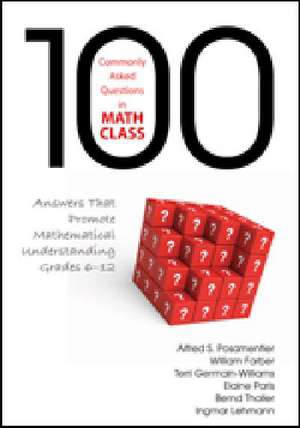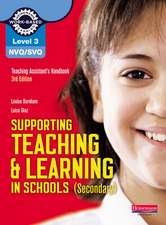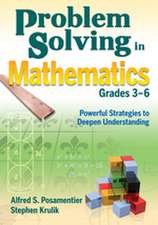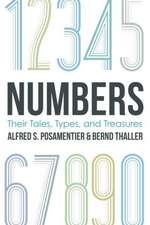100 Commonly Asked Questions in Math Class: Answers That Promote Mathematical Understanding, Grades 6-12
Autor Alfred S. Posamentier, William L. Farber, Terri L. Germain-Williams, Elaine S. Paris, Bernd Thaller, Ingmar H. Lehmannen Limba Engleză Paperback – 24 noi 2013
The questions are all organized around the Common Core's math content standards and relate directly to Numbers and Quantity, Functions, Algebra, Geometry, and Statistics and Probability. The big benefits? You'll discover high-interest ways to:
Teach inquiry and process in mathematical thinking
Encourage flexibility in problem solving
Emphasize efficient test-taking strategies
Provide practical applications from mathematics, education, and human development research
Build students' procedural skills and conceptual understanding
Preț: 297.39 lei
Nou
Puncte Express: 446
Preț estimativ în valută:
56.91€ • 60.85$ • 47.45£
56.91€ • 60.85$ • 47.45£
Carte tipărită la comandă
Livrare economică 18 aprilie-02 mai
Preluare comenzi: 021 569.72.76
Specificații
ISBN-13: 9781452243085
ISBN-10: 1452243085
Pagini: 232
Dimensiuni: 178 x 254 x 15 mm
Greutate: 0.48 kg
Ediția:1
Editura: SAGE Publications
Colecția Corwin
Locul publicării:Thousand Oaks, United States
ISBN-10: 1452243085
Pagini: 232
Dimensiuni: 178 x 254 x 15 mm
Greutate: 0.48 kg
Ediția:1
Editura: SAGE Publications
Colecția Corwin
Locul publicării:Thousand Oaks, United States
Recenzii
"Several years ago a group of mathematics teachers develop a list of mathematics concepts and skills they identified as “Tough Topics to Teach.” This list was made up of middle and high school mathematics topics that these experienced teachers felt unprepared to teach well and questions that were frequently raised by students that they felt unprepared to answer. One Hundred Commonly Asked Questions in Math Class provides a clear and concise explanation of each topic on that list and much more. It is an invaluable resource for new and experienced teachers and their students as well."
"Everything you always wanted to know about mathematics but were afraid to ask. This is the "tell all" math book you've been waiting for!"
"Finally, there is a book that meets a genuine educational need: providing mathematics teachers with comprehensive responses to student questions. Unfortunately, teachers are sometimes unprepared for the myriad of student questions - thereby leaving them frustrated. Here is the solution!"
"Fear is not a mathematical term, but to most teachers fear of teaching math is. For most of us, the idea of math is an exercise in mystery where only egg heads reside and fun never enters the equation. The math teacher who reads this book begins the transformation from terror of teaching to "let's do another one." Curiosity covers a lot of distance between math avoidance and "Wow, I didn't know that." Like in most endeavors, curiosity is motivation in action and this book is a map connecting many areas which seem unrelated into a cohesive base of operation."
"One Hundred Commonly Asked Questions in Math Class makes a serious attempt to demystify long-standing mathematical concepts, especially for adolescents and teenagers. While many concepts will still require further explanation, it comes as a relief to know that some of the mysteries will be resolved."
"Everything you always wanted to know about mathematics but were afraid to ask. This is the "tell all" math book you've been waiting for!"
"Finally, there is a book that meets a genuine educational need: providing mathematics teachers with comprehensive responses to student questions. Unfortunately, teachers are sometimes unprepared for the myriad of student questions - thereby leaving them frustrated. Here is the solution!"
"Fear is not a mathematical term, but to most teachers fear of teaching math is. For most of us, the idea of math is an exercise in mystery where only egg heads reside and fun never enters the equation. The math teacher who reads this book begins the transformation from terror of teaching to "let's do another one." Curiosity covers a lot of distance between math avoidance and "Wow, I didn't know that." Like in most endeavors, curiosity is motivation in action and this book is a map connecting many areas which seem unrelated into a cohesive base of operation."
"One Hundred Commonly Asked Questions in Math Class makes a serious attempt to demystify long-standing mathematical concepts, especially for adolescents and teenagers. While many concepts will still require further explanation, it comes as a relief to know that some of the mysteries will be resolved."
Cuprins
About the Authors
Introduction
Chapter One. General Questions
1. Why do I have to learn mathematics?
2. Is there a language connection between mathematical terms and common English words?
3. How many leaves are on a tree?
4. Why do we have to learn about the history of mathematics?
5. Who introduced the Hindu-Arabic numbers to the Western world, and when?
6. What are the three famous problems of antiquity?
7. What are the Fibonacci numbers?
8. What is the golden ratio?
9. Is there a smallest number, and is there a largest number?
10. Why is infinity not a number?
11. How large is infinity?
12. Is there anything larger than infinity?
13. Can the union of two sets ever be equal to the intersection of the two sets?
14. How can we determine how many subsets a given set has?
15. How can we avoid making an error in a "proof" that leads to a generalization?
16. How does a calculator function?
17. Which is correct--my calculating, the calculator, or the computer?
18. What are conic sections?
19. What is a mathematical group?
20. What is a mathematical ring?
21. What is a mathematical field?
22. What are the three famous laws that Johannes Kepler discovered about planetary motion involving the ellipse?
Notes
Chapter Two. Arithmetic Questions
23. What is the difference between a number and a digit?
24. What are the differences between cardinal, ordinal, and nominal numbers?
25. What are the natural numbers, and does the number zero belong to the natural numbers?
26. How can we remember the order of operations using PEMDAS?
27. What is a fraction?
28. What is a rational number?
29. How can one convert a decimal number to a fraction?
30. What is so special about the Pascal triangle?
31. How can the product of two numbers be smaller than both of its factors?
32. If the temperature rises from 80 degrees F to a temperature of 88 degrees F, why is it wrong to say it became 10% warmer?
33. How do the values of the following differ? (order of operations)
34. Why is division by zero not permissible?
35. Why is x multiplied by 0 = 0?
36. What is 0!?
37. What is the largest number that can be represented in the decimal system with three digits (and without using any other symbols)?
38. What is a prime number?
39. Does the number 1 belong to the prime numbers?
40. How many prime numbers are there?
41. What is a palindrome?
42. What are successive percentages?
Notes
Chapter Three. Algebra Questions
43. Why is the product of two negative numbers positive?
44. Why must a and b be positive in order for the following to hold true?
45. Why is it advantageous to rationalize the denominator?
46. What is meant by the "absolute value" of a variable?
47. What is a variable? A term? An expression? An equation?
48. How can we have students realize that the average of rates is not simply the arithmetic mean?
49. Why does 0.99999 . . . = 1?
50. Is a road with a slope of 20% twice as steep as a road with a 10% slope?
51. Is there a number that differs from its reciprocal by 1?
52. What is a determinant, and how can it be used to solve a system of linear equations?
53. How do the arithmetic, geometric, and harmonic means compare in magnitude?
54. What is a function?
55. What is meant by the inverse of a function?
56. Can a function be equal to its inverse?
57. What is a 1-1 onto function?
58. Where does the quadratic formula come from?
59. What is a parabola?
60. How can you find the turning point of a parabola?
61. What is an ellipse?
62. What is a hyperbola?
63. When does one use the Law of Sines?
64. When does one use the Law of Cosines?
65. What is the difference between y = arccos x and y = cos-1 x?
66. What is a vector?
67. Why can a vector not be divided by a vector?
68. What is i?
69. What is e?
Notes
Chapter Four. Geometry Questions
70. Why is the diagonal of a square longer than its side?
71. How can you demonstrate that the circumference of a circle is 2 pi r?
72. How can you demonstrate that the area of a circle is equal to pi r squared?
73. Can a triangle contain two right angles?
74. Why must the sum of any two sides of a triangle be greater than the third side?
75. How do the terms "acute angle" and "obtuse angle" relate to the English language?
76. Can trigonometry be used to prove the Pythagorean theorem?
77. How is the distance formula derived?
78. How can the Pythagorean theorem be used to determine if an angle of a triangle is acute or obtuse?
79. What is a Platonic solid?
80. What is a golden rectangle?
81. What is a golden triangle?
82. From which point in a triangle is the sum of the distances to the three vertices smallest?
83. What is the sum of the distances from a point in a triangle to its three sides?
84. What is President James A. Garfield's proof of the Pythagorean theorem?
85. What is the nine-point circle?
86. How can the Pythagorean theorem be proved by paper folding?
87. How can we prove that the sum of the measures of the angles of any triangle is 180 degrees using paper folding?
88. What figure is created by joining the midpoints of any quadrilateral?
89. How can the concurrency of the medians of a triangle be proved in one step?
Notes
Chapter Five. Probability Questions
90. What is the fundamental principle of counting?
91. What does it mean when the probability of an event is 1? Is 0?
92. What are mutually exclusive events?
93. What is the probability of either or both of two events happening?
94. What is the difference between combinations and permutations?
95. What is the difference between correlation and causation?
96. What is the Pascal triangle?
97. What is binomial probability?
98. What is the birthday problem?
99. How can algebra help us to understand a probability question?
100. What kind of averages are batting averages?
Index
Introduction
Chapter One. General Questions
1. Why do I have to learn mathematics?
2. Is there a language connection between mathematical terms and common English words?
3. How many leaves are on a tree?
4. Why do we have to learn about the history of mathematics?
5. Who introduced the Hindu-Arabic numbers to the Western world, and when?
6. What are the three famous problems of antiquity?
7. What are the Fibonacci numbers?
8. What is the golden ratio?
9. Is there a smallest number, and is there a largest number?
10. Why is infinity not a number?
11. How large is infinity?
12. Is there anything larger than infinity?
13. Can the union of two sets ever be equal to the intersection of the two sets?
14. How can we determine how many subsets a given set has?
15. How can we avoid making an error in a "proof" that leads to a generalization?
16. How does a calculator function?
17. Which is correct--my calculating, the calculator, or the computer?
18. What are conic sections?
19. What is a mathematical group?
20. What is a mathematical ring?
21. What is a mathematical field?
22. What are the three famous laws that Johannes Kepler discovered about planetary motion involving the ellipse?
Notes
Chapter Two. Arithmetic Questions
23. What is the difference between a number and a digit?
24. What are the differences between cardinal, ordinal, and nominal numbers?
25. What are the natural numbers, and does the number zero belong to the natural numbers?
26. How can we remember the order of operations using PEMDAS?
27. What is a fraction?
28. What is a rational number?
29. How can one convert a decimal number to a fraction?
30. What is so special about the Pascal triangle?
31. How can the product of two numbers be smaller than both of its factors?
32. If the temperature rises from 80 degrees F to a temperature of 88 degrees F, why is it wrong to say it became 10% warmer?
33. How do the values of the following differ? (order of operations)
34. Why is division by zero not permissible?
35. Why is x multiplied by 0 = 0?
36. What is 0!?
37. What is the largest number that can be represented in the decimal system with three digits (and without using any other symbols)?
38. What is a prime number?
39. Does the number 1 belong to the prime numbers?
40. How many prime numbers are there?
41. What is a palindrome?
42. What are successive percentages?
Notes
Chapter Three. Algebra Questions
43. Why is the product of two negative numbers positive?
44. Why must a and b be positive in order for the following to hold true?
45. Why is it advantageous to rationalize the denominator?
46. What is meant by the "absolute value" of a variable?
47. What is a variable? A term? An expression? An equation?
48. How can we have students realize that the average of rates is not simply the arithmetic mean?
49. Why does 0.99999 . . . = 1?
50. Is a road with a slope of 20% twice as steep as a road with a 10% slope?
51. Is there a number that differs from its reciprocal by 1?
52. What is a determinant, and how can it be used to solve a system of linear equations?
53. How do the arithmetic, geometric, and harmonic means compare in magnitude?
54. What is a function?
55. What is meant by the inverse of a function?
56. Can a function be equal to its inverse?
57. What is a 1-1 onto function?
58. Where does the quadratic formula come from?
59. What is a parabola?
60. How can you find the turning point of a parabola?
61. What is an ellipse?
62. What is a hyperbola?
63. When does one use the Law of Sines?
64. When does one use the Law of Cosines?
65. What is the difference between y = arccos x and y = cos-1 x?
66. What is a vector?
67. Why can a vector not be divided by a vector?
68. What is i?
69. What is e?
Notes
Chapter Four. Geometry Questions
70. Why is the diagonal of a square longer than its side?
71. How can you demonstrate that the circumference of a circle is 2 pi r?
72. How can you demonstrate that the area of a circle is equal to pi r squared?
73. Can a triangle contain two right angles?
74. Why must the sum of any two sides of a triangle be greater than the third side?
75. How do the terms "acute angle" and "obtuse angle" relate to the English language?
76. Can trigonometry be used to prove the Pythagorean theorem?
77. How is the distance formula derived?
78. How can the Pythagorean theorem be used to determine if an angle of a triangle is acute or obtuse?
79. What is a Platonic solid?
80. What is a golden rectangle?
81. What is a golden triangle?
82. From which point in a triangle is the sum of the distances to the three vertices smallest?
83. What is the sum of the distances from a point in a triangle to its three sides?
84. What is President James A. Garfield's proof of the Pythagorean theorem?
85. What is the nine-point circle?
86. How can the Pythagorean theorem be proved by paper folding?
87. How can we prove that the sum of the measures of the angles of any triangle is 180 degrees using paper folding?
88. What figure is created by joining the midpoints of any quadrilateral?
89. How can the concurrency of the medians of a triangle be proved in one step?
Notes
Chapter Five. Probability Questions
90. What is the fundamental principle of counting?
91. What does it mean when the probability of an event is 1? Is 0?
92. What are mutually exclusive events?
93. What is the probability of either or both of two events happening?
94. What is the difference between combinations and permutations?
95. What is the difference between correlation and causation?
96. What is the Pascal triangle?
97. What is binomial probability?
98. What is the birthday problem?
99. How can algebra help us to understand a probability question?
100. What kind of averages are batting averages?
Index
Notă biografică
Descriere
Anticipate common math questions, eliminate pat responses, and provide explanations that are certain to engage and motivate students. Al Posamentier and his coauthors have all the answers.













